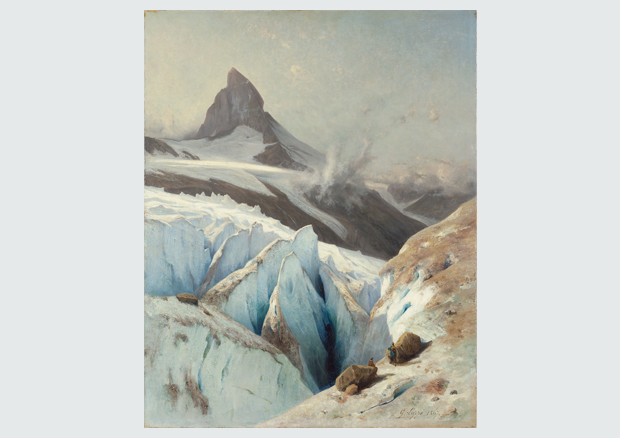Things Fall Apart Swiss Art from Böcklin to Vallotton
The Kunstmuseum Bern is showing around 200 works from its collection from the perspective of Sigmund Freud’s text in which he speaks of three major humiliations of human narcissism. Alongside masterpieces by Arnold Böcklin, Ferdinand Hodler, Albert Anker, Adolf Wölfli and Félix Vallotton, the extensive exhibition of pieces from the collection also includes works by women artists who have so far received less attention, such as Annie Stebler-Hopf and Clara von Rappard. «Things Fall Apart» is the first exhibition curated by Marta Dziewańska at Kunstmuseum Bern.
The starting point for the exhibition is Sigmund Freud’s 1917 essay about the three humiliations of human narcissism. According to Freud, three scientific discoveries have fundamentally shaken humanity’s understanding of itself: Copernican cosmology, Charles Darwin’s theory of evolution and Freud’s own theory of the unconscious. What Freud describes in his essay as a narcissistic humiliation is the discovery that man is not the centre of the universe and rules neither over nature nor even over himself.
The exhibition takes as its theme the mood of uncertainty, the disenchantment of the world, but also flight from the world and longing for the marvellous. In the works of this time, mirrors, hermaphrodites and inner rooms appear with increasing frequency, objects and symbols of the unsettled ego. Human beings are shown as indefinable, alienated and fleeting, the clear idea of the self is breaking down. Idyllic landscape paintings make way for a menacing and monumental picture of nature. The tension between the animate and the inanimate is particularly apparent in Ferdinand Hodler’s «Aufstieg und Absturz» (1894). The lack of distance, the monumentality, the impossibility of giving a context to the scene, as well as the threatening power of nature are combined here with a feeling of tragedy and triumph. Man becomes the insignificant factor in view of overwhelming nature. Works such as Gabriel Loppé’s depiction of «Das Matterhorn» (1867) show a barren alpine landscape with sharp-edged icy peaks around in which the two hikers seem to disappear. Paintings such as Arnold Böcklin’s famous «Meeresstille» (1887) create a fabulous alternative to the actual reality of the late 19th century, thus addressing issues of dream and reality. Human figures are not only merely copied and depicted, but direct their gaze inwards. Albert Anker paints unprettified and psychologically acute portraits of old people or a drinker, and in his famous self-portrait «Der Zornige» (1881) Ferdinand Hodler shows a moment of inner agitation. But the insecure ego does not just struggle with the awareness of not being completely master of its own inner life. The outside world also becomes increasingly unstable. The fragmentary and often sketchy art works reflect the impossibility of conveying an objective and comprehensive depiction of the (outside) world.
«It is a concern of ours to keep on re-examining our highly diverse collection. Precisely through unfamiliar perspectives we are able to achieve a fresh view of well-known masterpieces, and at the same time we can also give room to previously lesser-known artists.»
Nina Zimmer, Director, Kunstmuseum Bern – Zentrum Paul Klee
The show at the Kunstmuseum Bern shows Swiss art of the 19th and early 20th century, including major works by Ferdinand Hodler, Arnold Böcklin, Paul Klee, Félix Vallotton, Cuno Amiet and Alexandre Calame. Alongside highlights by the well-known Swiss painter the exhibition also includes works by often overlooked women artists such as Annie Stebler-Hopf or Clara von Rappard. The exhibition is arranged as a thematic tour which, in around ten stages, sheds light on human insecurity in the face of scientific discoveries. The works show, in exemplary form, artists’ engagements with the experience of the alien within themselves, they show identity crises and vertigo, the experience of overwhelming nature, and present us with creatures that are half human, half animal.
«The idea behind this exhibition is to look at the historical collection and to ask it contemporary questions. Its aim is to broaden the spectrum of possible interpretations of the canon: open it up, propose alternative readings and cast a new light on history and tradition. I am very interested in the ways of how art of the past can become mirror for the art, but also for the more general questions and challenges of the present.»
Marta Dziewańska, curator Kunstmuseum Bern
Curators Marta Dziewańska, curator Kunstmuseum Bern Etienne Wismer, co-curator «Things fall apart»
Contact
Maria-Teresa Cano
Head of Communication and Public Relations Kunstmuseum Bern – Zentrum Paul Klee , Tel.: +41 31 328 09 44
To the press area
(Please log in to download the image material)


